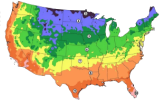Balang Information
The Balang (Citrus medica), belonging to the citrus family, is renowned for its large, yellow, pear-like fruit. What distinguishes the Balang from other citrus fruits is its thick rind, which is commonly used to make a flavorful jam. Both the fruit and its blossoms are highly aromatic, adding to the tree's appeal. This evergreen tree can grow tall, offering shade and ornamental beauty.
In the regions of Gīlān and Māzandarān in Iran, the fruit’s rind is used to produce morabbā-ye bālang, a delicious jam made from the skin of the ripe fruit. This traditional jam is cherished for its sweet and slightly tangy flavor.
Care Tips:
- Climate: Balang thrives in warm, Mediterranean-like climates and is particularly well-suited for USDA zones 9-11. It can tolerate mild frost but prefers hot summers for optimal growth and fruit production.
- Soil: The tree prefers well-drained, slightly acidic to neutral soil. Adding organic matter like compost will improve soil health and support the tree's growth.
- Watering: While drought-tolerant once established, Balang trees benefit from regular deep watering during dry spells, particularly in the fruiting season.
- Pruning: Prune the Balang tree lightly to manage its size and shape, encouraging air circulation and sunlight exposure for healthier growth. Removing dead or damaged branches helps to maintain the tree's vitality.
- Pest and Disease Control: Keep an eye out for common citrus pests such as aphids, citrus scale, and spider mites. Regular inspection and the use of organic insecticidal soaps or neem oil can help control infestations. Fungal diseases like root rot may affect trees grown in poorly drained soils, so ensure proper drainage.
Health Benefits: Like other citrus fruits, Balang contains vitamins and antioxidants, particularly vitamin C, which supports immune function and skin health. The rind is also rich in dietary fiber, aiding digestion, and its essential oils have potential antimicrobial properties.
Cultural Significance: Balang holds cultural importance in Persian cuisine, where it has been used for centuries to make morabbā-ye bālang. The fruit is considered a symbol of freshness and vitality, often featured in festive dishes and celebrations.
Uses:
- Culinary: The rind of the Balang fruit is its most prized part, often candied or used in jams and marmalades, particularly in Middle Eastern and Persian cuisine. Morabbā-ye bālang is a delicacy often enjoyed with bread or as a sweet accompaniment to tea. The aromatic zest can also be used in desserts, sauces, or baked goods to infuse a citrusy fragrance and flavor. The fruit’s juice, though not as commonly used, can be added to beverages and marinades for its tangy twist.
- Aromatic Uses: The intense fragrance of Balang flowers and fruit has traditional uses in perfumery and aromatherapy. The blossoms can be distilled into essential oils, while the zest can be dried and added to potpourri.










